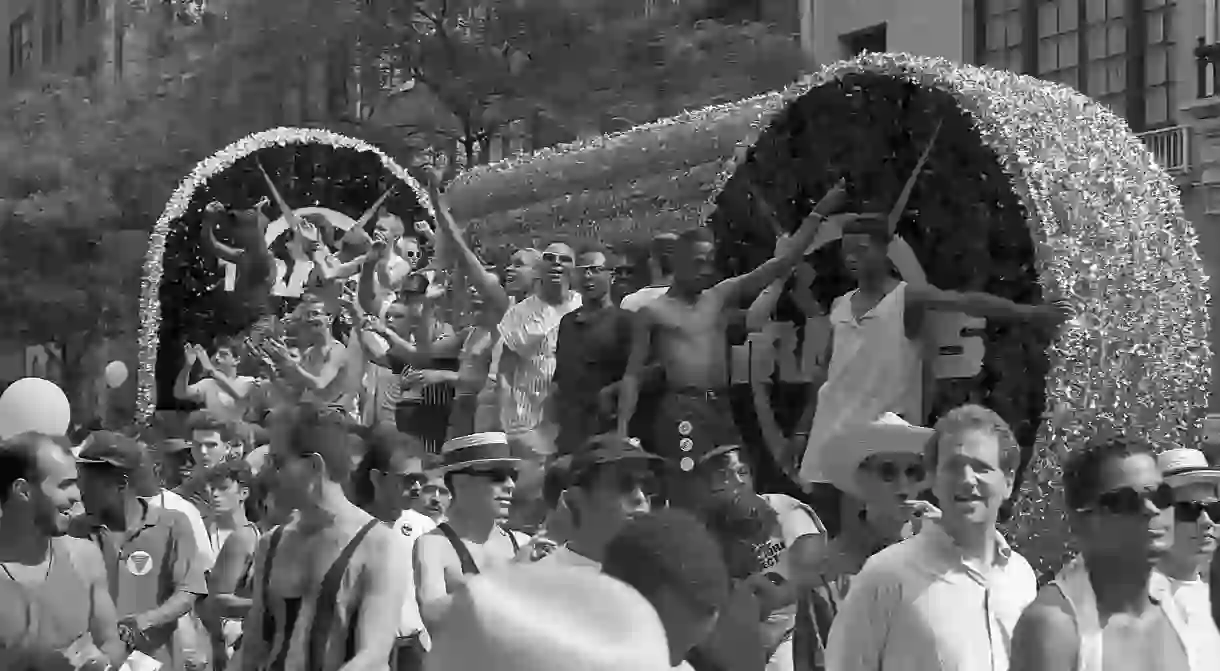Why We Celebrate LGBT Pride: A Brief History

As you are out and about in June, you may notice an unusual number of rainbow flags mingling at parades and outside of bars and storefronts. You probably know that the rainbow flag symbolizes LGBT pride, and may be wondering why it is celebrated so visibly in the month of June.
There are two answers to that question, both of which require us to look at American history.
The origins of LGBT Pride month are in the famous Stonewall Riots, which occurred on June 28, 1969, in the Greenwich Village neighborhood of New York City. The Stonewall Inn was a Mafia-owned bar in the Village that was one of the few establishments to openly welcome gay people, especially some of the more marginalized members of the gay community, including drag queens, homeless youth, and male prostitutes.

On the night of June 28th, the police conducted one of their routine raids at the Stonewall Inn. Although bar owners were typically tipped off before raids, the bartenders at the Stonewall Inn that night don’t remember being warned that the raid was going to happen.
It was customary during police raids for patrons to line up, with their ID cards ready to be checked, and anyone found to be in drag (after anyone in women’s clothing was taken to the bathroom to have their sex checked) would be arrested. But that night at the Stonewall, those dressed as women refused to go to the bathroom to be checked. Then others in line refused to hand over their IDs. There are reports that some of the police officers began to assault some of the lesbians present by feeling them up while frisking them.
The police had to wait for backup paddy wagons to transport the alcohol they were going to seize. And while they waited, those who had not been arrested decided to linger outside the Stonewall, where a larger curious group of people began to form. By the time backup police arrived, there was a crowd of between 100 and 150, who started singing “We Shall Overcome” and jeering at the police as their fellow patrons were loaded into paddy wagons.

Things turned violent when a woman in handcuffs was beaten on the head with a baton after complaining that her handcuffs were too tight. “Why don’t you guys do something?” she yelled at the onlookers. And that was when the scuffling and violence broke out. Some of the arrested escaped. The crowd tried to turn over the wagons, and others joined them, with the group swelling to include those sympathetic to the protesters due to their own experience of being roughly treated by the police during anti-war demonstrations. Some of the police barricaded themselves inside Stonewall for their safety. Protesters ripped a parking meter out of the street and used it as a battering ram to break down the door. They also stuffed flaming garbage through broken windows. When backup arrived, the protesters, some of whom the police were trying to arrest, formed a chorus line to repel them. When the riots finally calmed at four in the morning, almost everything in the Stonewall Inn was broken.
But a movement had been launched. Many progressives were moved by the protesters and their cause. Activists focused on creating spaces where people could express their sexual orientations openly. Gay rights organizations focusing on more confrontational strategies were established, along with several newspapers to promote gay rights. New gay rights advocacy groups sprung up around the country, and they took care to mark and celebrate the first anniversary of the riots.

It was the work that one of these activists did on the first anniversary of the riots that holds the roots of Pride Month. The organizer of the New York City commemoration of the rally was bisexual rights activist and sex-positive feminist Brenda Howard, who spearheaded the “Christopher Street Liberation Day March.” But Howard didn’t stop there. She also had the original idea for a week-long series of events around the anniversary of the riots and, along with her fellow LGBT activists L. Craig Schoonmaker and Stephen Donaldson, came up with the idea for the word “Pride” to describe the June events. Howard would go on to spend her life fighting for the rights of the LGBT community and was highly active in advocating for the passage of New York City’s gay rights law in 1987, along with numerous national initiatives.
So, if you are lucky enough to be in New York at the end of June, swing by the Stonewall Inn to commemorate a momentous event in the history of the United States in the most appropriate place possible. And if you’re anywhere else, take a moment at your local Pride parade or celebration to remember Brenda Howard, who had a vision and turned it into a reality still being celebrated all these years later.













